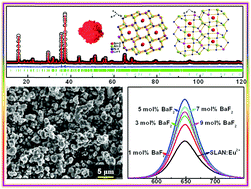J. Mater. Chem. C, 2016,4, 7332-7338. https://doi.org/10.1039/C6TC02093C

In this paper, narrow-band red-emitting SrLiAl3N4:Eu2+ phosphor has been successfully prepared using a solid-state reaction method. The effects of sintering temperatures, times and fluxes on phase formation and luminescence properties are investigated, respectively. The addition of BaF2 flux not only enhances room-temperature emission intensity, but also improves the luminescence thermal stability, which is ascribed to the increase of crystallinity. Under blue light excitation, the as-prepared SrLiAl3N4:Eu2+ phosphor has a narrow emission band with a peak wavelength at ∼648 nm and a full-width at half-maximum of ∼1177 cm−1 (∼50 nm). The critical quenching concentration of Eu2+ is about 1 mol%. White light-emitting-diode (w-LED) devices have been fabricated which are obtained by combining a 455 nm chip with the commercial yellow phosphor and the present red phosphor. The results exhibit a potential application for phosphor-converted LEDs (pc-LEDs).



